Register your interest
JOIN OUR MAILING LIST FOR PROGRAM UPDATES:
Get Involved
Email [email protected] to help, volunteer, or participate in an event.
Episode 5 - Live, In-person and Off-screen
When we pose questions in person, allowing ideas to pass between us as bodies inhabiting a shared physical space, do we arrive at different understandings than when questions are conveyed at a distance online? Do we gain different insights? Are we led in entirely new directions? In this 3-day gathering around artistic propositions, creative research and deep listening, live-ness replaces the mediated online world as our discursive and imaginative space. Presented in assembly, symposium, performance and moving image modes, the creative patterns set in train over the previous four SPECTRAvision episodes will be newly weaved, cast aside or apprehended as we work towards a better set of questions. The intention is to expose, explore and amplify the dynamics of the current epoch and to use our resources collectively and vividly to consider our respective places and possible futures. Curated by David Pledger with Alex Kelly, Nina Sellars, Tony Briggs, Zena Cumpston, produced by Madeleine Collie.
Thursday 21 April - Future Propositions
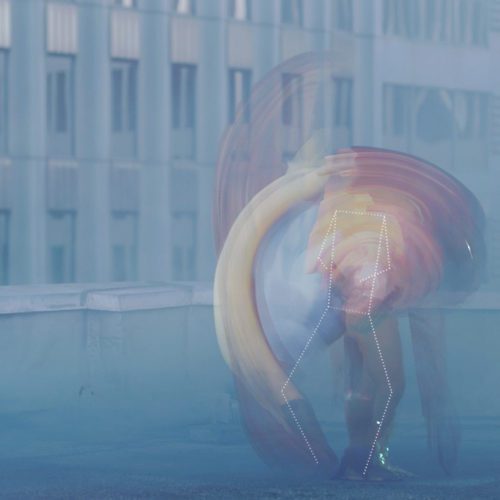
Still from Choreographic Camouflage Directed and Designed by Liam Young, Choreography by Jacob Jonas, Performed by Jacob Jonas The Company.
9am – 10am, Black Box Theatre, Science Gallery & Oculus Courtyard, Melbourne Connect
Welcome and Registrations
Arrive at 9am to register for the three day event.
There will be a Welcome to Country in the Oculus Courtyard at 9:30am
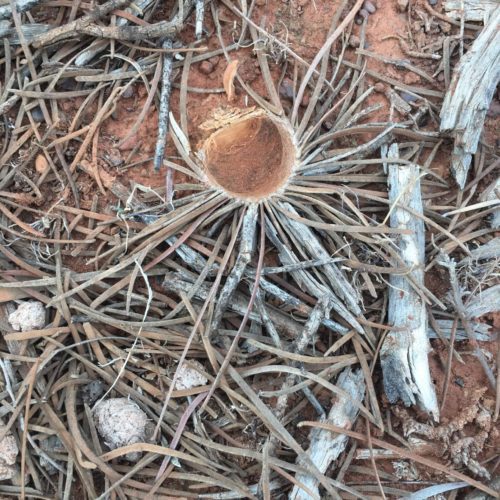
Idiosoma genus in Goldfields region, research image. Photo: Dr Leanda Mason
Morning 10am – 11am, Black Box Theatre, Science Gallery
Earth is in Time on Time
Concepts of time not only influence our individual sense of identity but also shape the qualities of our diverse cultures and the accompanying narratives of their histories. Time is understood not as a universal, but rather as a multiplicity. In this proposition, we explore how Indigenous knowledge and Earth System Science (ESS) frame time respectively —through notions of deep-time, non-linear time, and the proposed geological epoch of our era, the Anthropocene. The session raises the question—how do these frames directly impact on the way humans deal with profound changes to our climate and on the ways in which we produce knowledges more broadly?
This session features Climate Councillor and Earth Systems Scientist, Professor Will Steffen and writer and researcher Cass Lynch, descendant of the Noongar people.
Accessibility: The Science Gallery is fully accessible venue, and the event will include live captioning.
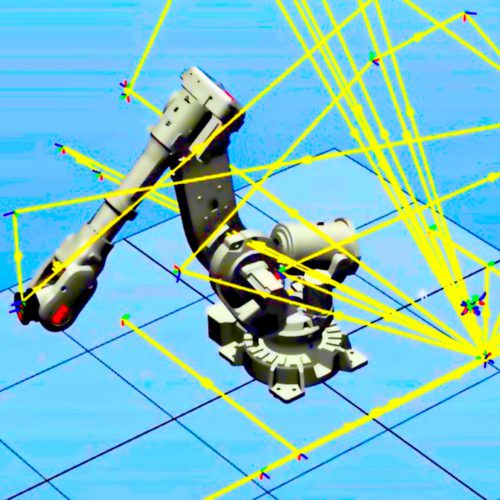
Stelarc, Propel, digital image, 2022
Morning 11am -12pm, Black Box Theatre, Science Gallery
Friends Are Electric
Is the distinction between the machine and the human remaining firm, or are we rapidly transmuting into the fluid realm of the posthuman?
For over 50 years Australian performance art legend, Stelarc, has generated contestable futures whilst creating alternative anatomical architectures. Reimagining the cyborg, his embodied presence is a constant provocation to our ways of being human and our corporeal integration with the machine.
Burmese Australian entrepreneur Reggie Ba Pe’s practice is more sci-fi than sci-fact. He heads up the Avastar agency where he creates virtual humans. His world extends the fascination of authors such as William Gibson who prefigured Second Life cultures and the doppelganger constructs that are typical of the avatars whom Reggie now represents.
After short presentations of their work, they will be engaged in a conversation with RMIT Vice-Chancellor’s Indigenous Pre-Doctoral Fellow, Megan Kelleher, whose research area sits at a unique intersection, that of Indigenous knowledge systems and blockchain mapping.
Accessibility: The Science Gallery is fully accessible venue, and the event will include live captioning.
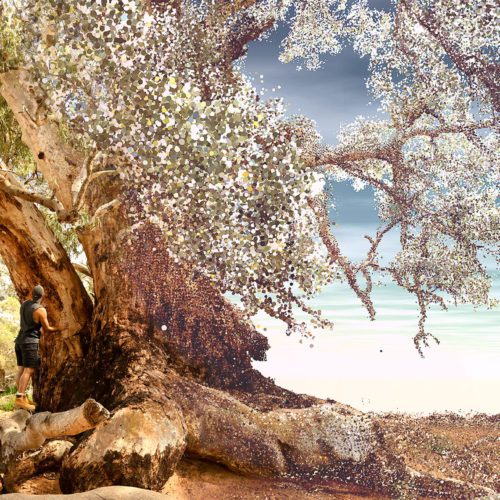
Baden Pailthorpe, Adam Goodes and Old Ways, New, 3D point cloud of significant red river gum tree, Adnyamathanha Yarta, South Australia.
Morning 12pm – 1pm, Black Box Theatre, Science Gallery
This is The Tracker Data Project
The Tracker Data Project is a collaboration involving palawa~trawlwoolway woman, Old Ways New founder, Professor Angie Abdilla, Adnyamathanha/Narungga man, former elite athlete and Indigenous leader Adam Goodes, and contemporary artist and academic Baden Pailthorpe. Theirs is a story steeped in artistic and cultural collaboration, deep personal connection and a dramaturgical approach to the creative process which connects art, culture and society. The project uses new software development and spatial technologies to interrogate Adam’s performance data from his AFL playing career and regenerate it in a new kinetic, aesthetic and immersive field. In an open conversation, the team will address these elements and the research and development process which decompresses the reductive nature of data capture.
Accessibility: The Science Gallery is fully accessible venue, and the event will include live captioning.
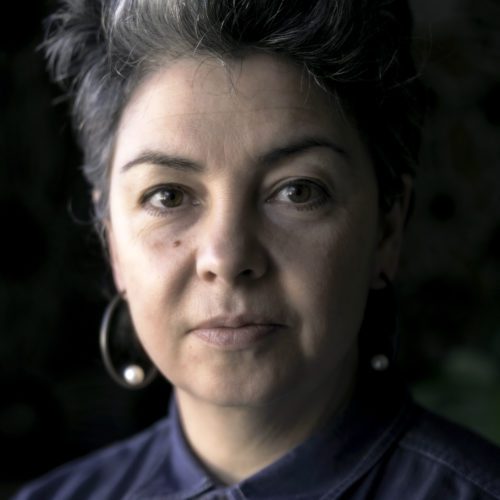
Professor Zena Cumpston, 2029, Barak University BLAKFULLAS Campus.
Afternoon 2pm -4:30pm, Black Box Theatre, Science Gallery Melbourne
Assembly for the Future at Blakfullas University
Led by The Keeper of Time, the assembly is transported into the future to experience a startling provocation before becoming future-makers themselves. In 2029, we meet Professor Zena Cumpston from the National Sky Rangers Program who delivers the 2029 Moreton-Robinson annual address. Celebrating the first five years of the BLAKFULLAS (Blak Lives And Knowledge Fundamentals University for Living knowledge Living culture And Solidarity) University, Professor Cumpston reflects on the past decade and the incredible transformations taking place as First Nations leadership and Country are given overdue authority and resources. The rapid progressions of this all-Indigenous University are examined in detail, allowing us to together reflect on the possibilities powerfully evidenced when self-determination becomes reality.
This provocation from 2029 will be responded to by civil society advocate and year 12 student Ahelee Rahman, and astrophysicist and Kamilaroi woman Krystal De Napoli, following which an ensemble of artist-moderators will steward participants in the speculation of new worlds in future-making rooms. Artist-moderators will in turn create artworks as records of these new worlds, which will be published the next week as Dispatches from the Future.
Featuring: Keeper of Time, Alex Kelly; First Speaker, Zena Cumpston; Respondent, Ahelee Rahman; Respondent, Krystal de Napoli; Usher, Robbie McEwan / Artist Moderators: April Phillips, Eleanor Jackson, Jen Rae, Jordan Lacey, Nina Sellars, Zoe Scoglio, Jenna Lee, Huong Truong / Creative Team: Alex Kelly, David Pledger, Sophia Marinos, Robbie McEwan, Elliat Rich.
Accessibility: The Science Gallery is fully accessible venue, and the event will include Auslan interpretation and live captioning. It will be recorded and made available a week following the event with Auslan interpretation and closed captioning.
The Dispatches from the Future will be published online in a variety of formats (including poetry, graphic story, video, audio and essay) together with image descriptions, transcripts of audio content and plain-text versions of written content compatible with Screen Readers.
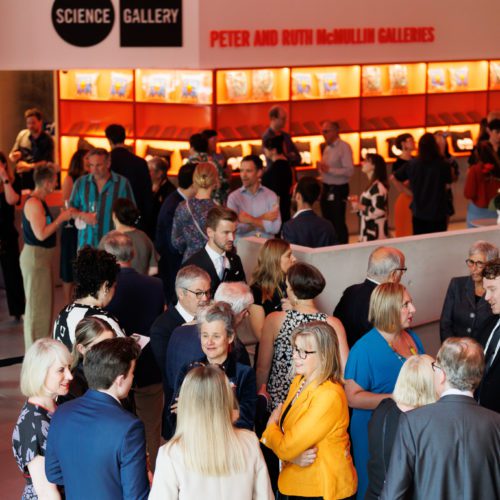
Science Gallery Opening. Photo: James Henry
6pm – 8pm, Mental Exhibition, Science Gallery
Opening Night Party
Celebration is a critical part of how we care for each other. We want to extend this connection of community in person. We’ll keep the speeches short and sweet before announcing the arrival of two VIPs from the future.
Friday 22 April - Edge of Practice
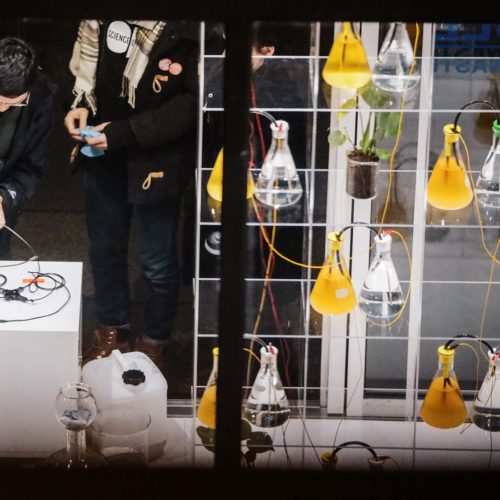
Sandra and Gaspard Bébié-Valérian and Peter Scales, Urinotron, 2019. Photo: Nicole Cleary
9:30am – 1:30pm Black Box Theatre, Science Gallery Melbourne
The Good, The Bad, The Living Lab
Why do artists collaborate across disciplines?
Collaborative practice can be both problematic and beneficial. It can enable institutions to exert greater influence and commercially exploit ideas but can also lead to unexpected and exciting outcomes. In 2022, the practice of collaboration has a social agency in addition to practice contexts. ‘Making together’ can be a political act, a way of achieving a shared consciousness in an increasingly atomised world or a way to solve problems and future global challenges. In these contested times, collaboration is as much a metaphor for community as a mode of creative practice.
Hosted by Science Gallery Melbourne’s Director, Ryan Jefferies, and Head of Curatorial, Tilly Boleyn, this session features seven research presentations in which collaboration is key to practice. Ryan and Tilly will frame and moderate each session with explications of Science Gallery collaborations that acknowledge success and failure, expectation and (no) outcome, and that reach deep into the heart of why we as a community need to work together.
Jeffrey Hannam and Pamela Bain, Chris Henschke, Paul Thomas and Matteo Volpi, Jules Moloney, Simon Twose, Anastasia Globa and Lawrence Harvey, Niki Sperou, Jenny Hickinbotham and Joel Stern, Julianne Pierce and Margie Medlin, and David Harris.
Accessibility: The Science Gallery is fully accessible venue, and the event will include live captioning.
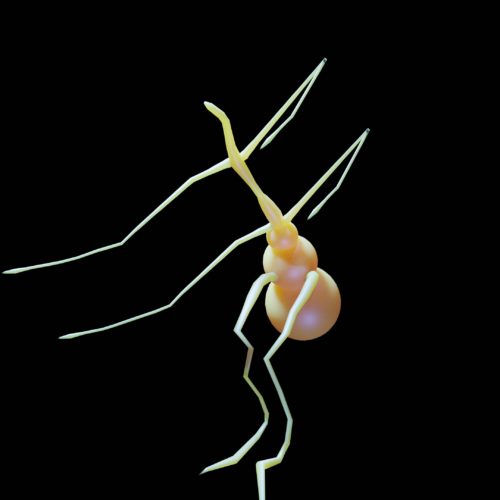
2pm – 4:30pm Melbourne Connect Studio, Ground Floor
Reality Contest
Virtual Reality Demonstrations from artists and dancers
This presentation features Glasshouse and Aurora Australis Ultimo Choro. Glasshouse questions travel in post-COVID-19 times through the metaphors of a Glasshouse keeper (resident), plants (nomads) and insects (tourists). Each perspective is presented as a separate yet interdependent world housed in a futuristic biosphere managed by the farming of weather. Participants experience each world in the scale, colours and movements choreographed into tasks specific to each entity – glasshouse keeper, plant and insect.
Sarah Neville’s new dance for Virtual Reality work, was devised over twelve months as the final outcome of an Arts SA Fellowship.
Aurora Australis Ultimo Choro depicts the final voyage of the RSV Aurora Australis to Antarctica. The Aurora Australis has been carrying expeditioners, scientists and resupply to Antarctica for over 30 years. This final voyage was special in many ways, departing with COVID-19 just a whisper and returning to a fundamentally changed world. This VR experience giving a unique insight into an Australian icon and the powerful choreography required to collectively face adversity.
John McCormick and Adam Nash were the 2020 Australian Antarctic Arts Fellows on the final Antarctic voyage of the Aurora Australis
Accessibility: This demonstration is held in a wheelchair accessible venue, and there are accessible amenities on the ground floor. This experience has a high degree of immersive visual content and is not considered suitable for people with very low vision, however those wearing glasses can keep them on within the headset.
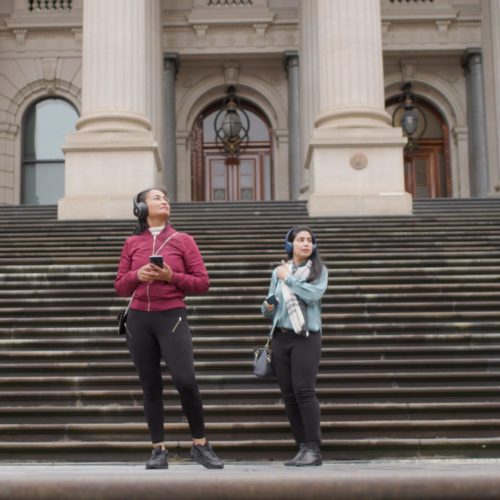
2pm – 4pm Melbourne CBD, meet on the Steps of Parliament House
64 Ways of Being
64 Ways of Being is a self-guided immersive theatre experience that works with the city as a creative material, reimagining Melbourne’s identity through its creative, linguistic, cultural, social and urban diversity. It brings together environmental and Indigenous histories, speculative fiction and layers of public space. Each way of being is a confluence of place, play, affect and language – mapped through emotional cartography. Threaded throughout the journey is the story of Naarm as the site of what was once a series of interconnected breathtakingly biodiverse wetlands.
Led by urban play scholar and creator of 64 Ways of Being, Dr Troy Innocent, supported by One Step At A Time Like This and Milipede
Accessibility: This experience is not wheelchair accessible. This experience has a high degree of immersive visual content and is not considered suitable for people with low vision and/or hearing impairments.
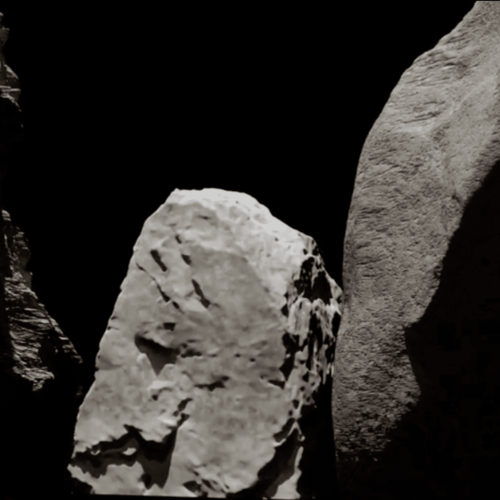
E. Vella, A. Chapman, G. Duric, A. Michalewicz, J.Green, R. Walton, D. Williams, T. Keep Can you trust a stone? Rehearsing future human-robot swarms via ancient standing stones, 2022. Photo Credits: R. Walton, T. Keep
2pm – 2:50 pm & 3pm – 3:50 Flight Lab, meet at Department of Mechanical Engineering, University Melbourne
Can You Trust a Stone?
Could you trust a robot to collaborate with you? If so, would the same rules apply to robot swarms? What if the robots were presented as standing stones, an ancient and cross-cultural phenomenon observed globally? These questions propel the interdisciplinary research project, A New Approach to Ancient and Emerging Technologies, the creative outcome of which will be the performance installation, Sacrifice. Approaching the research from perspectives of performance art, machine intelligence, mechatronics, fabrication, archaeology, and philosophy, the team offers insights into their collaborative process and demonstrates interactive swarm behaviour with a collective of small ground vehicles and their digital twins in virtual reality.
Presented by Elena Marie Vella, Airlie Chapman, Goran Duric, Aleks Michalewicz, Justin Green, Robert Walton and Daniel Williams
Accessibility: This experience is wheelchair accessible. This experience has a high degree of immersive visual content and is not considered suitable for people with low vision and/or hearing impairments.
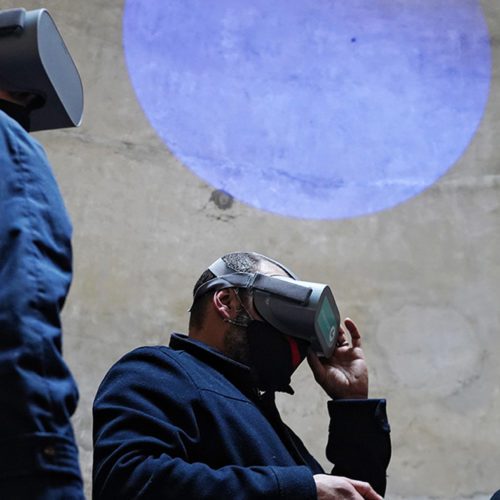
Fiona Hillary, Reverberating Futures, audience image, 2021
Posthuman PUBLICS: Reverberating Futures
This sound walk explores our implication in climate change through a performative delivery of the experience of oceanic entanglement with bioluminescent dinoflagellates. Your guides orient you to experience the 360° sound and film work in VR headsets or via your handheld device (please bring headphones). Audience members will experience entanglements with technology, site, and non-human companions in the warming waters of anthropogenic oceans.
Led by Naarm-based artist Fiona Hillary, the work is presented with the kind support of the State Library of Victoria and ANAT.
Accessibility: This experience is wheelchair accessible. This experience has a high degree of immersive visual content and is not considered suitable for people with low vision and/or hearing impairments.
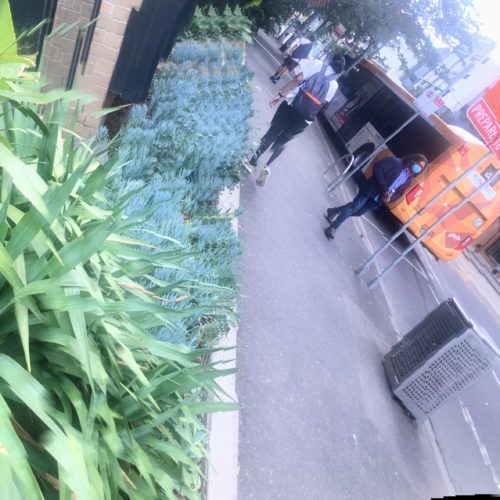
3pm – 4.30pm Melbourne CBD, meet in the Oculus Courtyard, Melbourne Connect
Walking While Listening
Join artist David Chesworth on a 90 minute guided sound walk starting from the Science Gallery courtyard, culminating in a discussion of the experience of sound in public spaces, and sound in art. Sound is an elusive yet integral component of our everyday experiences, however we often don’t consciously notice how sound is constantly providing us with a sense of place while providing information about our evolving surroundings. As an artist with a rigorous engagement with sound, David is an ideal guide in this experience of absorbing and understanding sound on a new level.
Led by sound artist David Chesworth
Accessibility: This experience is wheelchair accessible. This experience has a high degree auditory content and is not considered suitable for people with hearing impairments.
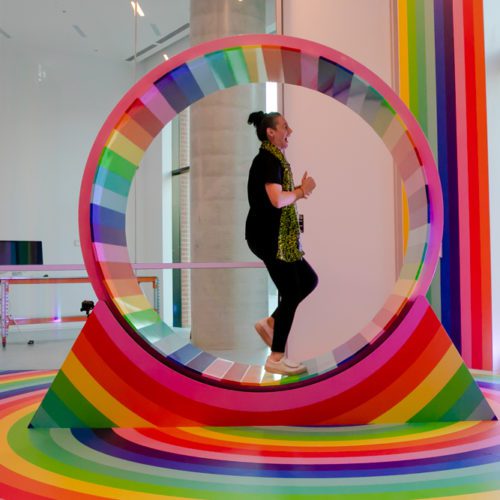
Hiromi Tango and Emma Burrows, Wheel, 2021. Photo: Alan Weedon
3:30pm – 4pm Science Gallery, meet at the front desk
Wheel, Curator and Artist Talk
A collaboration between Hiromi Tango, an interdisciplinary artist, and Dr Emma Burrows, a neuroscientist, Wheel explores how positive brain stimulation can be encouraged through arts engagement by creating an immersive, participatory installation work that provides rich sensory, cognitive and physical experiences. This talk will explore what it means to enable and develop art/science collaborations around complex topics. Chaired by Tilly Boleyn, Head of Curatorial at Science Gallery Melbourne, the panel will unpack what it means for researchers to move from the lab to the gallery – from mice to humans – and to study the effects of physical activity on mood and behaviour in public settings. We will discuss how art/science collaborations come to life, how science finds its way into art (and vice versa) and how artworks go viral. And we will also address the burning question: why and how on earth you supersize a hamster wheel into a rainbow-coloured running wheel for humans.
Presented by Head of Curatorial Tilly Boleyn, artist Hiromi Tango and Dr Emma Burrows
Accessibility: The Science Gallery is fully accessible venue, and the event will include live captioning.
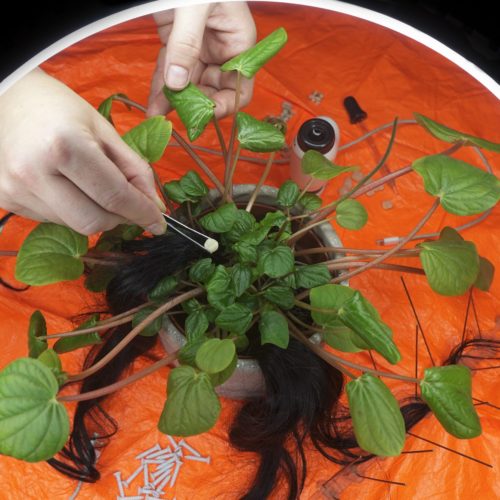
MEEP 2082, Lab documentation
4:45pm – 5pm Black Box, Science Gallery Melbourne
Multispecies Engagement Evaluation Program (MEEP)
In a future that foregrounds multiplicity, who is considered a participant in a program like SPECTRA? MEEP are future envoys and independent arts evaluators from the year 2082, arriving to evaluate multi-species inclusion and participation in ANAT SPECTRA 2022. Throughout the symposium, MEEP will be auditing participant relations across species and scales, including animal, plant, fungal, atmospheric, lithic, and algorithmic persons. With a focus on more-than-human equity and speculative futures, MEEP proposes evaluation as worldmaking, and ask whether we can evaluate multiplicitous futures into being. Here, MEEP will briefly engage the symposium as a multi-species collective, presenting a summary report based on their evidence gathering.
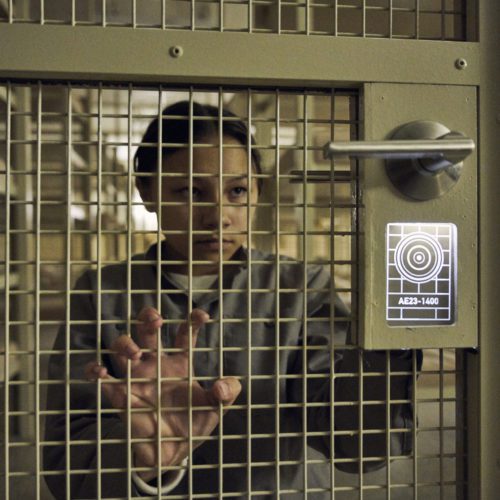
5pm – 7:30pm Black Box, Science Gallery Melbourne
Friday Night at The Movies
What does our future look like? What kind of people will we be 20 years from now?
In John Harvey’s Water (2017) and Danis Goulet’s Night Raiders (2021), both filmmakers depict lived experience of Indigenous peoples in the 2040s. In both stories, the protagonists fight to adapt to conditions which challenge their survival, forcing them to discover new ways of resisting and overcoming adversity.
Water – Directed and written by John Harvey (Torres Strait ) | 2017 | 13 mins
In the year 2047, with strict population control in place, a pregnant woman finds herself stranded on a dry salt lake, struggling to survive with very little water as she evades authorities.
Night Raiders – Directed & Written by Danis Goulet (Cree Métis ) | 2021 | English & Cree | 97 mins Feature Film Victorian Premiere
The year is 2043. A military occupation controls disenfranchised cities in post-war North America. Children are property of the State. A desperate Cree woman joins an underground band of vigilantes to try to rescue her daughter from a state-run institution. Night Raiders is a female-driven dystopian drama about resilience, courage and love.
Tony Briggs, Artistic Director of Birrarangga Film Festival and curator of SpectraVision’s Future Cultures episode, will introduce the films including a short pre-recorded interview with Cree-Métis film director and writer of Night Raiders, Danis Goulet.
Curated by Tony Briggs and Produced by Damienne Pradier for Typecast Entertainment.
Accessibility: The Science Gallery is fully accessible venue, closed captions and hearing loop is available for this event.
Saturday 23 April - Deep Listening
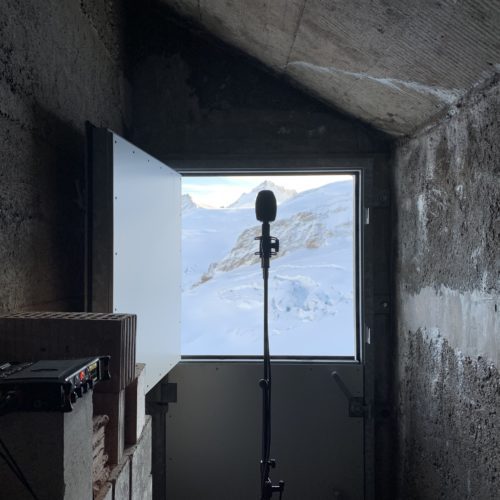
Philip Samartzis, High Altitude Research Station at Jungfraujoch, 2019, Digital Image. Photo Philip Samartzis (or courtesy of the artist)
10.30am-11.20am, The Capitol, RMIT University
Atmospheres and Disturbances
World Premiere Immersive Sound Work
How do we viscerally understand the profound effects of changes to our landscape brought about by changes to climate? Philip Samartzis’ Atmospheres and Disturbances places audiences deep inside an extreme environment to afford embodied experiences of an alpine ecology under duress. The composition features multiple encounters: Bise and Föhn winds that dynamically converge to express the precarious nature of life on the exposed ridge; specialist scientific instrumentation used to register upper atmospheric gases which are central to understanding the long-term consequences of greenhouse gas emissions and sonic artefacts produced by the hard and permeable materials and surfaces of the research station transformed through stress and fatigue. Within this framework, Atmospheres and Disturbances offers a portrait of a place in which a future without ice may be a fait accompli. Its sounds, like its glaciers, are similarly at risk of becoming mere apparitions within a spectral landscape.
Supported by Creative Victoria; High Altitude Research Station at Jungfraujoch; Institute for Computer Music and Sound Technology at the ZhDK; RMIT School of Art; Swiss National Science Foundation.
Accessibility: The Capitol is fully accessible venue. The event contains a high degree of auditory content and is not considered suitable for those that have hearing challenges.
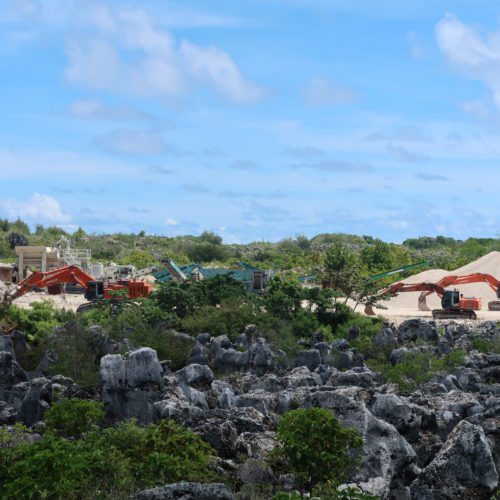
AM Kanngieser. Nauru Topside phosphate mine. 2018. Photo credits: AM Kanngieser
11:30am – 12:15pm, The Capitol, RMIT University
Listening to Ecocide
Lecture/Performance
This work focuses on the Pacific Island of Nauru, situated at the heart of the Pacific Ocean, the frontline of the environmental crisis. Strip-mined by colonisers of its natural phosphate reserves, Nauru has over the past decade been reliant on the economy of Australia’s brutal offshore refugee incarceration regime. Now facing severe eco-systemic vulnerabilities such as contaminated water, diminishing land, droughts and sea inundation, Nauru’s environment exemplifies the highly economically and socially precarious position induced by a combination of extractive colonialism and racial capitalism.
Bringing together site-specific audio recordings with Indigenous Nauruan voices campaigning for self-determination and self-representation, geographer and sound artist, AM Kanngieser shows how sound and listening are vital to understanding, and amplifying, the deep relations to land and sea that Nauruans hold. These relations are integral to understanding the complexities that frontline Pacific communities face.
Accessibility: The Capitol is fully accessible venue. The event contains a high degree of auditory content and is not considered suitable for those that have hearing challenges. A Large Print Transcript of the text will be made available to audiences that need assistance.
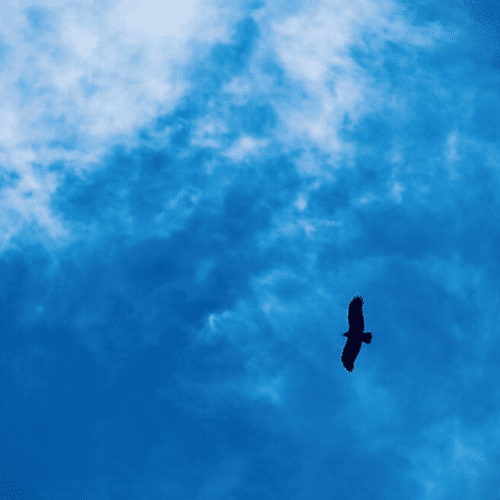
Leah Barclay, Tricia King, David Harris, Sensing Environments, digital image, 2022
12:30pm – 12:50pm, The Capitol, RMIT University
Sensing Environments
Audio-Visual Artwork
What does it mean to navigate the rainforest canopy from the perspective of a microbat? How can we learn from the temporal complexity of seasonal algae? How does our body change when we listen from the perspective of plants?
This audio-visual work by Leah Barclay, Tricia King, David Harris and Lyndon Davis (Gubbi Gubbi) traverses a diversity of local environments across the recently embattled Sunshine Coast incorporating satellite imagery from the perspective of a Black Cockatoo in flight to sensing soundscapes as migrating whales in the depths of the ocean, revealing deep connections to place and community. Sensing Environments is created on Kabi Kabi and Jinibara Country and features the voice of Kabi Kabi artist Lyndon Davis.
Leah Barclay, Tricia King, David Harris and Lyndon Davis (Gubbi Gubbi)
Accessibility: The Capitol is fully accessible venue. The event contains a hight degree of auditory content and is not considered suitable for those that have hearing challenges.
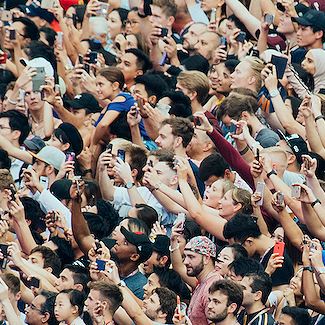
2pm – 3:30pm, Storey Hall, RMIT University, Swanston Street, Melbourne
A Ministry for Multiple Futures
Collective Conversation
Inspired by The Ministry for the Future, the latest offering from science fiction’s most progressive author, Kim Stanley Robinson, this event apprehends his optimistic take on the human species’ capacity to create a better, fairer future in the face of climate change.
Our Ministry is different. It is an intersectional, intergenerational, interdisciplinary and cross-temporal group whose task is to help synthesise the proceedings of Multiplicity. They reflect each episode back to us echoing pasts, presents and futures. Set in a series of listening circles, the ideas are delivered as snapshots designed to scale outwards embracing all participants in a collective conversation, in search of productive, resonant questions.
Accessibility: Storey Hall is fully accessible venue. The event contains a high degree of auditory content and is not considered suitable for those that have low hearing.
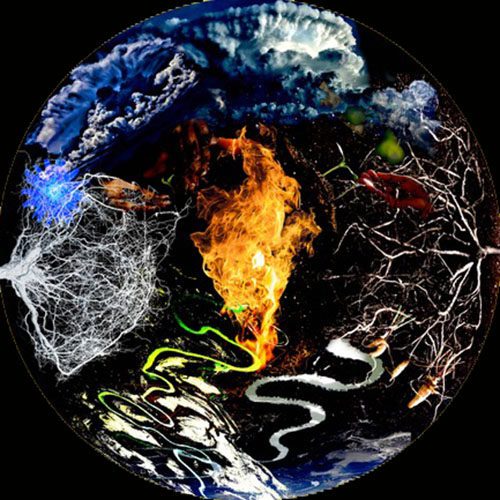
4:00pm – 5:00pm, Storey Hall, RMIT University, Swanston Street, Melbourne
The Planting
World Premiere Sound Feature
The Planting is a speculative documentary spatial audio artwork set in 2029, exploring the future impacts of climate change, social movements and caring for Country across the continent of so-called Australia. The work features interviews with Yuin man Bruce Pascoe, Barkindji woman Zena Cumpston, Canadian journalist Naomi Klein, Yorta Yorta woman Kathryn Coff and traditional fire practitioners Jason Smith and Danny Gardner, with field recordings from Landcare plantings on Djaara Country, of bird life on Wadawurrung, the Gulidjan and the Gadubanu Country and features traditional burning workshops in lutruwita. The work is a deep listening experience, presented on a speaker orchestra.
Lead Artist, Alex Kelly; Composition & Sound Design, Lawrence Harvey; Dramaturg, David Pledger; Additional Composition, Aaron Cupples; Producer, Sophia Marinos; Design, Elliat Rich; Additional sound, Anna Cadden, Zoe Scoglio. Featuring Bruce Pascoe, Naomi Klein, Kathryn Coff, Zena Cumpston, Danny Gardner, Jason Smith and members of Castlemaine Landcare.
Supported by SIAL Studios at RMIT University, The Bertha Foundation Bertha Challenge Fellowship, Mount Alexander Shire Council and the Castlemaine State Festival and its supporters for the FURTHER program Sidney Myer Fund, Playking Foundation, Australia Council for the Arts and the Community Impact Fund.
Accessibility: Storey Hall is fully accessible venue. The event contains a hight degree of auditory content and is not considered suitable for those that have low hearing. A Large Print Transcript of the text will be made available to audiences that need assistance.
-

Still from Choreographic Camouflage Directed and Designed by Liam Young, Choreography by Jacob Jonas, Performed by Jacob Jonas The Company.
-
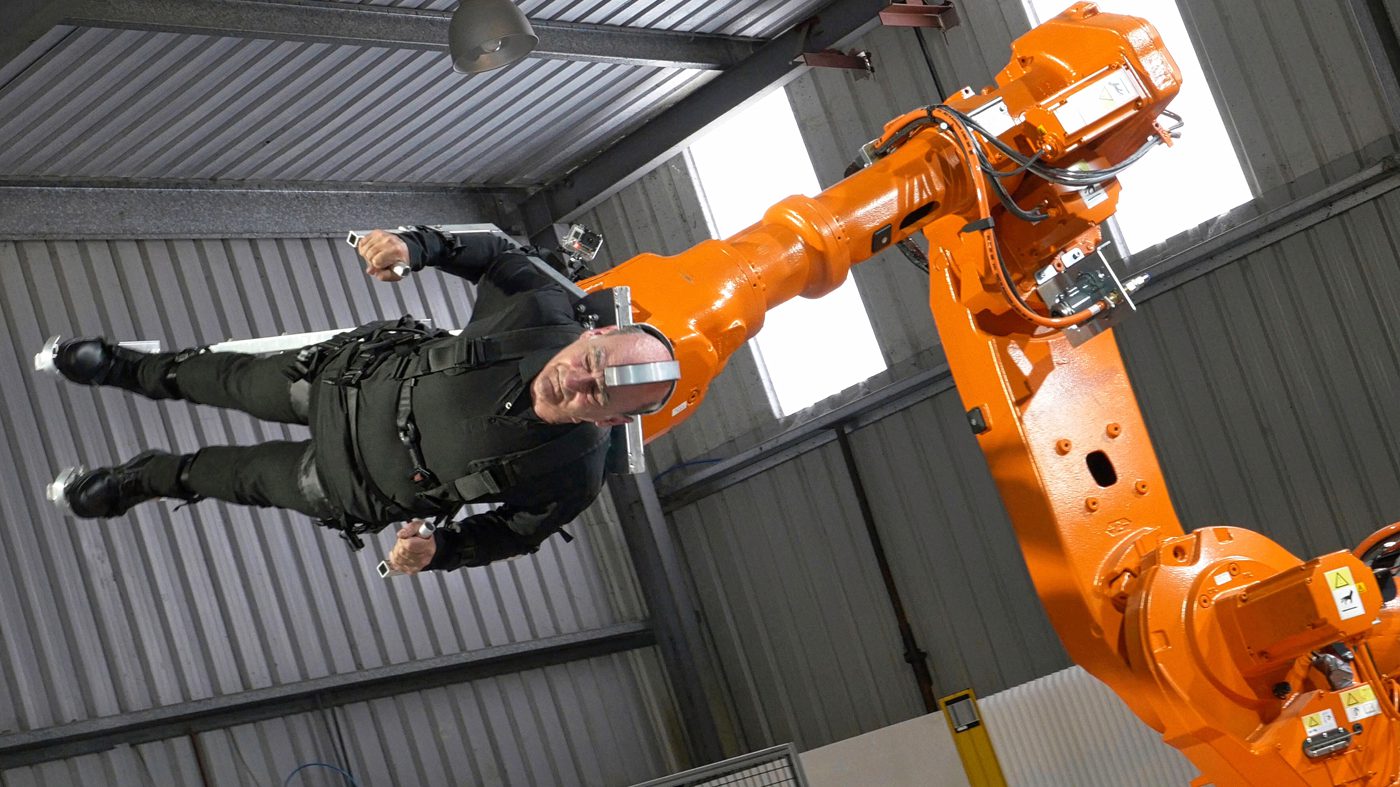
Stelarc, Propel: Body on Robot Arm, Demonstrable, Autronics / Lawrence Wilson Gallery, 2019 Photographer Steven Alyian.
-
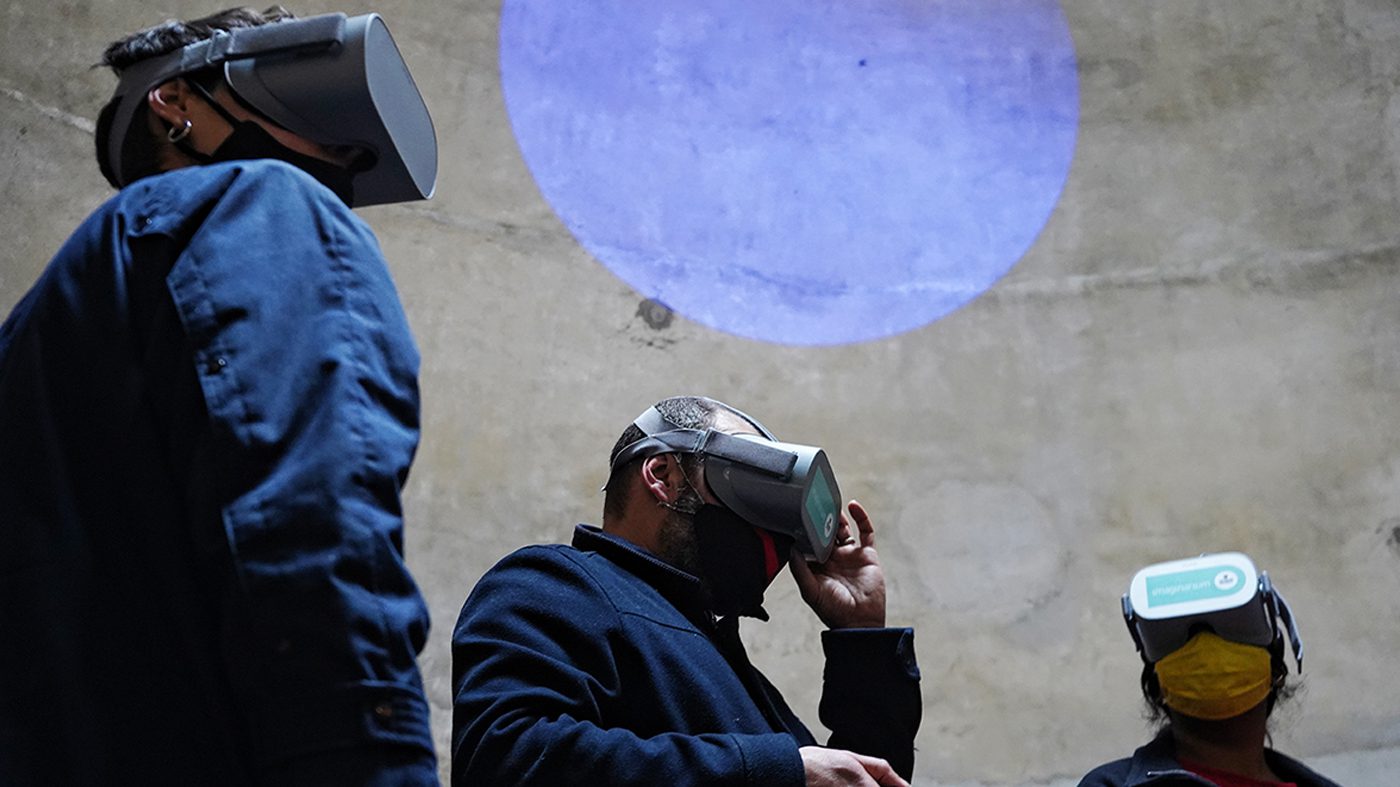
Fiona Hillary, Reverberating Futures, audience image, 2021
-
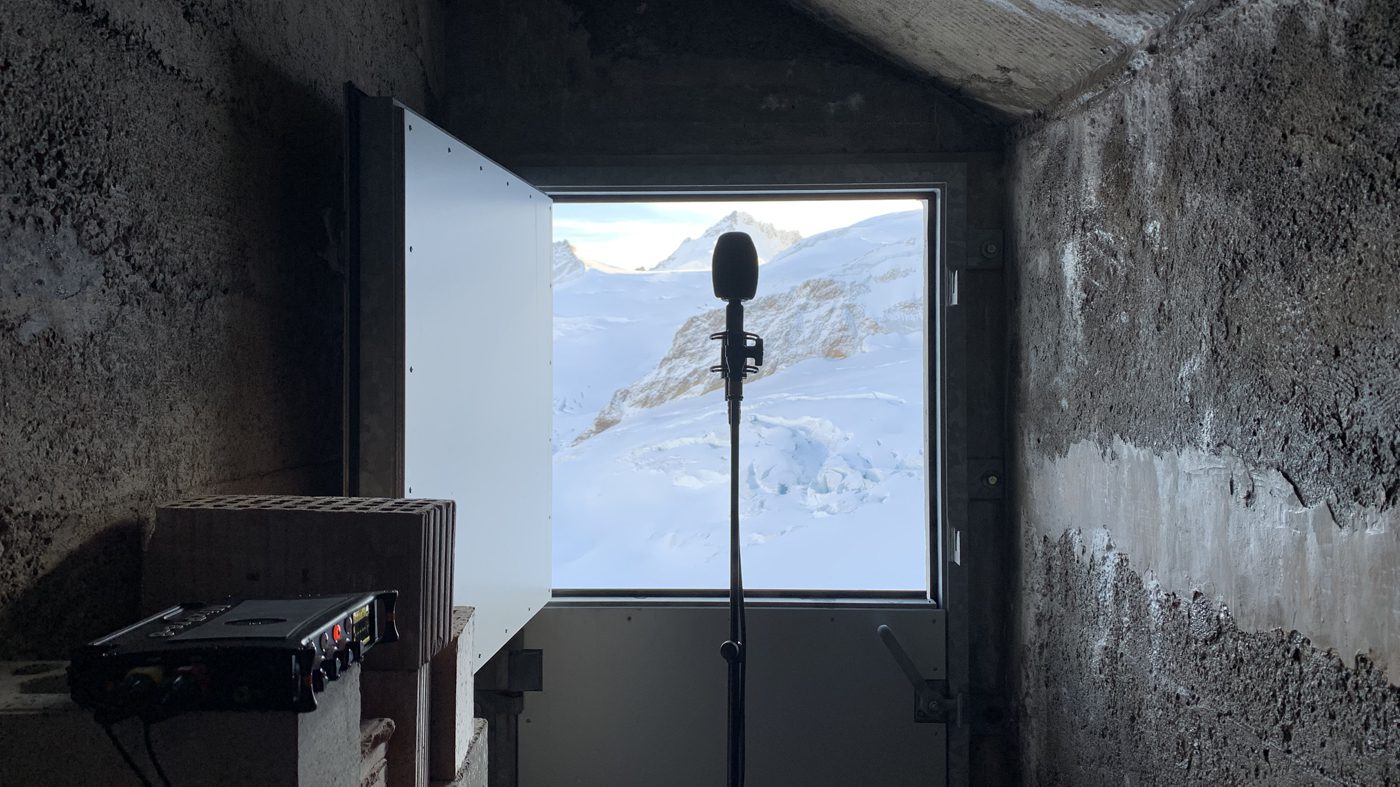
Philip Samartzis, High Altitude Research Station at Jungfraujoch, 2019, Digital Image. Photo Philip Samartzis.


